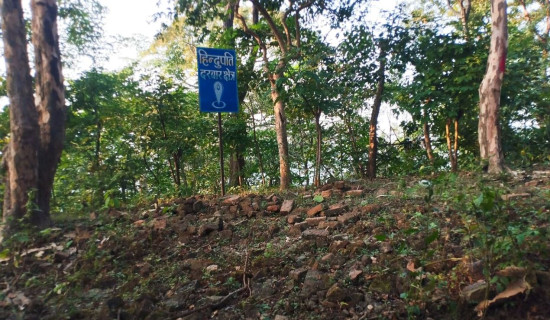- Friday, 28 November 2025
Calamities And Rajduwali Apocalyptic Saga
The incessant downpour that lashed Ilam district on the night of October 18 brought widespread devastation to life and property. More than 39 people lost their lives, while hundreds of roads and houses were damaged by floods and landslides. Many residents were displaced, and countless others were rendered homeless. Ilam district, renowned for its green tea gardens and scenic hills, has been suffering from destruction and instability– ironically in the name of “development.” Carelessness on the part of the government and private construction projects has only deepened the wounds inflicted by nature. They often undermine environmental sensitivity while carrying out development activities.
Even weeks after the disaster, state, provincial, and local governments have failed to respond to the people's woes with adequate planning and preparedness. The miserable Maikhola- Rajduwali road section of the Mechi Highway, under the Road Division Office, Ilam, and developed with local participation, is only a temporary fix-not a sustainable solution.
It is now brought to the fore that the Maikhola- Belase Fast Track and Godak- Simalgolai- Ilam routes could serve as more durable routes and one of them could be a permanent solution being the fastest one. Construction should not wait for the next monsoon; with winter and spring offering better weather, rebuilding must continue immediately. The question remains: What are the geological, human, or natural causes behind the repeated landslides and deterioration of the Rajduwali bridge area? Urgent geo-engineering studies, research by the concerned and strategic planning are essential, backed by adequate budgeting and long-term policies.
Stagnant development
Ilam seems trapped in a cycle of stagnant development for some months, much like the country’s stagnant and unstable politics. Major progress in education, agriculture, and tourism, the pillars of the local economy of Ilam, remains elusive. While regular transport could ease the movement of Ilam’s agricultural and cash crops, the Rajduwali road remains unfit for heavy vehicles. Natural disasters, which are unfortunate in themselves, continue to disrupt the rhythm of development, casting a shadow of sorrow and frustration over the region. It is time for local governments, communities, and both government and non-governmental organisations of the hilly districts of East Nepal to rethink their approach. The soil of Ilam should not be repeatedly dug up and destabilised in the name of development. Instead, the focus must shift toward nature-friendly, environment-sensitive, and sustainable development.
Amid the devastation, a new narrative has emerged around Rajduwali- one long- rooted in faith. Some locals believe that divine powers are angered by human negligence, misdeeds, pollution, and moral decay in the area. The discovery of five sacred rocks on the banks of the Maikhola River, believed to symbolise Pathibhara Kalika Devi, has sparked both reverence and controversy. Social media has been abuzz with stories of spiritual practitioners and devotees arriving from across the country to perform rituals, prayers, and meditation by the river under the guise of traditional superstitions. At the center of this faith movement stands 23-year-old Pramila Karki, who first foresaw in dream and identified the five rocks as symbols of divine presence on the Maikhola riverbed.
While her discovery deserves respect, true sanctity lies not in the stones alone, but in the purity of intention, truth in action, social harmony, and religious tolerance. Faith should unite, not divide the community and their sentiments. Followers of Sanatan Hinduism are reminded that religion should not become a business or political tool or source of dispute or thick humor and farce.
The essence of spirituality lies in love, forgiveness, and humility and not in greed, hypocrisy, ego or spectacle. It is said that “trying to take more than given is a sin; trying to take the same as given is business”. It may be easy to be religious, but it can be difficult to do selfless deeds and penance. Religious faith and worshipping nature and idols is deeply personal and sentimental or emotional. Whether one believes or not, it is a matter of individual rights and freedom. If someone worships a stone as a god, let him/her worship it. The tradition of worshipping natural elements such as stones, rivers, trees, mountains, the sun, and the moon has existed in Nepal since ancient times. Even if unseen and conversed with, divine power is felt through the harmony of nature and penance.
In Ilam’s sacred geography, seven rivers namely Mai, Jogmai, Puwamai, Deumai, Fakphokmai, Mayumai, and Sunmai are believed to be abodes of goddesses. Places like Maipokhari, Kutidanda, Gajurmukhi Dham, Singhbahini Devi, and Setidevi are revered as spiritual and religious centers of Ilam. Now, the recent emergence of Panchakanya Kalika Devi near the Maikhola Rajduwali area adds another chapter to this spiritual landscape. The Maikhola River itself is considered mighty and sacred, with an old saying claiming that offering its water to Maipokhari and Pathibhara is equivalent to reciting the twelve Puranas or serving a thousand needy souls. The route to Pathibhara and Maipokhari is also the Mechi Highway that passes through Maikhola.
Religious beliefs and scientific reasoning often walk separate paths. There are still many superstitions in society, the scientific truth and belief of which are shrouded in doubts and mystery. With fear and burden of skepticism, faith and belief thrive where science or logic ends. Yet, both reflect humanity’s desire to make sense of the world. As philosopher Nietzsche warned, “To claim one’s perspective as the ultimate truth is the most dangerous blindness.” Worshipping stones and idols is not a new phenomenon- it is a continuation of traditions described in the Skanda, Garuda, and Padma Puranas. Sacred stones are often identified by unique natural features like shape, colour, symbols, or energy. Of course, stones are stones at the foot of a mountain of stones; they do not have to be seen in dreams. But stone worship is also a religious belief. Whether or not one perceives a divine presence, faith gives meaning to the act.
The Maikhola Rajduwali area has long served various purposes- cremation grounds, forest and riverbed picnics, ritual sites, swimming, holy baths, melas and, at times, fishing, waste dumping zones and open toilets. After the devastating floods that paralysed the Mechi Highway- the lifeline of the hilly districts of East Nepal- locals are now advocating for the area’s transformation into a clean, sacred site dedicated to newly discovered Shakti Mata Maharani Panchakanya Devi.
A call for renewal
If faith and belief are personal freedoms, then respecting those who worship at Maikhola Rajduwali is a matter of social harmony and unity. However, spiritual revival must go hand in hand with environmental restoration, cleanliness and sanctity of the Rajduwali premises wishing that the landslide would stop forever. Proper management of the site- constructing public toilets, preventing waste dumping, cleaning the riverbanks, and reinforcing the area with strong retaining walls and public pathway is essential. Heavy vehicular movement should be regulated, and local communities must be involved in preserving both the natural and spiritual integrity of the site.
Nature and culture are two sides of the same coin. The problem lies not in the land or the river or technology, but in sheer human negligence and waywardness. It is, therefore, time to turn Ilam’s tragedy into an opportunity: to rebuild with respect for both nature and religious site, and to prudently establish Maikhola Rajduwali site as a model of harmony between culture and religion, environment and spirituality, and sustainable development.
(The author is an Associate Professor at MRMC, Ilam.)















